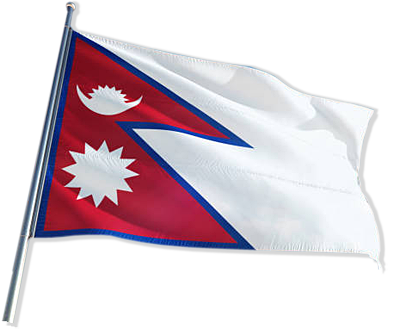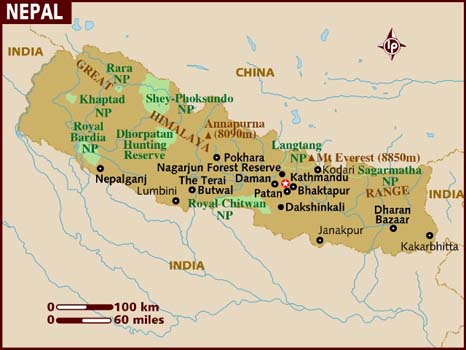Dear All
It is our pleasure to share our greetings for DASHAIN with you all
During the month of Kartik in the Bikram Sambat calendar (late September and early October), the Nepalese people indulge in the biggest festival of the year, Dashain. Dashain is the longest and the most auspicious festival in the Nepalese annual calendar, celebrated by Nepalese of all caste and creed throughout the country. The fifteen days of celebration occurs during the bright lunar fortnight ending on the day of the full moon. Thorough out the kingdom of Nepal the goddess Durga in all her manifestations are worshiped with innumerable pujas, abundant offerings and thousands of animal sacrifices for the ritual holy bathing, thus drenching the goddess for days in blood.
Dashain commemorates a great victory of the gods over the wicked demons. One of the victory stories told is the Ramayan, where the lord Ram after a big struggle slaughtered Ravana, the fiendish king of demons. It is said that lord Ram was successful in the battle only when goddess Durga was evoked. The main celebration glorifies the triumph of good over evil and is symbolized by goddess Durga slaying the terrible demon Mahisasur, who terrorised the earth in the guise of a brutal water buffalo. The first nine days signify the nine days of ferrous battle between goddess Durga and the demon Mahisasur. The tenth day is the day when Mahisasur was slain and the last five days symbolise the celebration of the victory with the blessing of the goddess. Dashain is celebrated with great rejoice, and goddess Durga is worshiped throughout the kingdom as the divine mother goddess.
In preparation for Dashain every home is cleansed and beautifully decorated, painted as an invitation to the mother goddess, so that she may visit and bless the house with good fortune. During this time the reunion of distant and nearby relatives occur in every household. The market is filled with shoppers seeking new clothing, gifts, luxuries and enormous supplies of temple offering for the gods, as well as foodstuffs for the family feasting. Thousands of sheep, goats, ducks, chicken and water buffalo are prepared for the great slaughter. All types of organisations are closed for ten to fifteen days. Labourers are almost impossible to find; from the poor to the rich, all enjoy the festive mood. Anywhere you go the aroma of ‘Vijaya Dashami’ is found.
The first nine days of Dashain are called nawa ratri when tantric rites are conducted. In Nepal the life force is embodied in the divine energy and power of the female, depicted as goddess Durga in her many forms. All goddess who emanated from goddess Durga are known as devis, each with different aspects and powers. In most mother goddess temples the deity is represented simply as a sacred Kalash, carved water jug or multiple handed goddess holding murderous weapons. During these nine days people pay their homage to the goddess. If she is properly worshiped and pleased good fortunes are on the way and if angered through neglect then misfortunes are around the corner. Mother goddess is the source of life and everything.
The first day of Dashain is called Ghatasthapana, which literally means pot establishing. On this day the kalash, (holy water vessel) symbolising goddess Durga often with her image embossed on the side is placed in the prayer room. The kalash is filled with holy water and covered with cowdung on to which seeds are sown. A small rectangular sand block is made and the kalash is put in the centre. The surrounding bed of sand is also seeded with grains. The ghatasthapana ritual is performed at a certain auspicious moment determined by the astrologers. At that particular moment the priest intones a welcome, requesting goddess Durga to bless the vessel with her presence.
The room where the kalash is established is called ‘Dashain Ghar’. Generally women are not allowed to enter the room where Dashain puja is being carried out. A priest or a household man worships the kalash everyday once in the morning and then in the evening. The kalash and the sand are sprinkled with holy water everyday and it is shielded from direct sunlight. By the tenth day, the seed will have grown to five or six inches long yellow grass. The sacred yellow grass is called ‘Jamara’. It is bestowed by the elders atop the heads of those younger to them during the last five days when tika is put on. The jamara is taken as a token of Goddess Durga as well as the elders blessing.
As days passes by regular rituals are observed till the seventh day. The seventh day is called ‘Fulpati’. On this day the jamara to be used by the royal household is brought from their ancestral royal house in Gorkha about a hundred and sixty nine kilometres away over the hills north west of the valley of Kathmandu. A parade is held in the Hanuman Dhoka Royal Palace. The fulpati, i.e. the procession bearing the jamara and other items necessary for the tika, is brought from Gorkha after a three day walk and most of the government officials are eagerly waiting for the fulpati parade to arrive at Rani Phokari in the afternoon. Rani Phokari area is filled with hundreds of government officials meticulously attired in the traditional formal dress.
In fulpati, the royal kalash filled with holy water, banana stalks, jamara and sugar cane tied with red cloth is carried by Brahmans from the ancestral royal house on a decorated palanquin under a gold tipped and embroidered umbrella, led by the military platoon of the royal priest. The government officials also join the fulpati parade. Whilst the fulpati parade is heading towards the old royal palace, His Majesty the King observes the ceremonies taking place in Tundikhel, the army parade ground in the center of the city. There a majestic display of the Royal Nepalese Army is held. Guns are fired and the entire valley echoes with the resonance sound of it.. The firing continues for ten to fifteen minutes to honour the fulpati. By the time the function ends the royal fulpati is already taken inside the Dashain ghar in Hanuman Dhoka Palace. With this the Dashain feasting starts.
The eighth day is called the ‘Maha Asthami’. The fervour of worship and sacrifice to Durga and Kali increases. On this day many orthodox Hindus will be fasting. Sacrifices are held in almost every house through out the day.. The night of the eighth day is called ‘Kal Ratri’, the dark night. Hundreds of goats, sheep and buffaloes are sacrificed at the mother goddess temples. In the darkness of the night Durga temples, army barracks, and old palaces all over Nepal hold sacrifices for the mother goddess. The sacrifice continues till dawn. The old palace in Basantapur Hanuman Dhoka, is active throughout the night with worships in almost every courtyard. While the puja is being carried out great feasts are held in the homes of common people where large amount of meat are consumed.
The ninth day is called ‘Nawami’. The Taleju temple at Hanuman Dhoka is opened for the public only once a year on this day. Thousands of people go and pay their respect to the goddess day. Temples of mother goddess are filled with people from dawn till dusk. On this day the official military sacrifices are held in the ‘Kot’ courtyard at Hanuman Dhoka. The government allows foreigners to witness this function so hundreds of tourists and diplomats eagerly gather here. Animals mostly black buffaloes are slaughtered by hundreds to honour Durga the goddess of victory and might and to seek her blessing. Military bands play war tunes, guns boom and officers with beautifully decorated medals in full uniform stand there. When the function ends the courtyard is filled ankle deep with blood. On this very day the god Vishwas Karma, the God of creativity is also worshiped. All factories, vehicles, any machinery instruments and anything from which we make a living are worshiped. We also give sacrifices to all moving machinery like cars, aeroplanes, trucks etc. to get the blessing from goddess Durga for protection for vehicles and their occupants against accidents during the year. The entire day is colourful.
The tenth day is the ‘Dashami’. On this day we take tika and jamara from our elders and receive their blessing. We visit our elders in their home and get tika from them while our younger ones come to our home to receive blessing from us. The importance of Dasain also lies in the fact that on this day family members from far off and distant relatives come for a visit as well as to receive tika from the head of the family. This function continues for four days. His Majesty also receives tika from the royal priests and then gives on tika to his loyal subjects. Thousands of loyal Nepalese people as well as foreigners also receive tika from His Majesty the King as this is said to be auspicious. After four days of rushing around and meeting your relatives Dashain ends on the full moon day, the fifteenth day. In the last day people stay at home and rest. The full moon day is also called ‘Kojagrata’ meaning ‘who is awake’. The Hindu goddess of wealth Laxmi is worshipped. On this day the goddess Laxmi is given an invitation to visit each and everyone.
After Dashain the nation settles back to normal. After receiving the blessing of goddess Durga, people are ready to work and acquire virtue, power and wealth. Dashain thus is not only the longest festival but also the most anticipated one among all the festivals of Nepal.
This is the information about Dashain ,
by Lila Nath Sapkota
Nepal i dag
Nepal har under senare år genomgått mycket stora politiska förändringar. Efter lång tid som kungadöme är landet nybliven republik med president som statschef. I april 2008 hölls val till en konstituerande församling och maoistpartiet blev överlägset största parti. Valet var ett led i fredsprocessen efter det nepalesiska inbördeskrigets slut år 2006, då förhandlingar mellan den maoistiska gerillan och regeringen ledde fram till ett fredsavtal.
I maj 2008 röstade den nyvalda konstitutionsförsamlingen för att avskaffa monarkin och i juni valdes Kongresspartiets kandidat Ram Baran Yadav till Nepals förste president. Maoistpartiet fick ingen egen majoritet i församlingen och bildade därför en koalitionsregering tillsammans med två andra partier. Maoisterna partiledare och tidigare gerillaledare Pushpa Kamal Dahal (också kallad Prachanda) utsågs till premiärminister. Nepal har sedan dess försökt anpassa sig till ett nytt politiskt system. I maj 2009 uppstod regeringskris då presidenten upphävde Prachandas beslut att avskeda den dåvarande arméchefen. Maoisterna lämnade regeringen och Madhav Kumar Nepal från partiet CPN-UML (de förenade marxist-leninisterna) bildade en ny koalitionsregering bestående av 22 partier. Motsättningarna mellan maoistpartiet och nuvarande regering har skapat en mycket problematisk politisk situation. Arbetet med att ta fram en ny författning har försenats och flera viktiga frågor för landets framtid förblir olösta.
FN har en övervakningsmission i Nepal, UNMIN (United Nations Mission in Nepal) vars nuvarande mandat sträcker sig fram till den 23 januari 2010. Sverige bidrar för närvarande med två militärobservatörer till insatsen. FN spelar en viktig roll i att övervaka freden och frågan om maoistsoldaternas framtid är central för den fortsatta utvecklingen. Nepal är ett av världens fattigaste länder och starkt beroende av bistånd. Nuvarande politiska situation är till men för landets ekonomiska och sociala utveckling.
Kort historisk bakgrund
Nepal fick sina nuvarande gränser på 1700-talet. 1850-1950 fördes en pro-brittisk politik samtidigt som Nepals ledare sökte hålla landet isolerat från omvärlden. Därefter har Nepal utvecklat relationer med främst Indien. På 1960-talet antog den dåvarande kungen en ny konstitution som stärkte kungafamiljens makt över landet. I samband med reformer 1990 övergick Nepal till ett flerpartisystem inom ramen för konstitutionell monarki.
Ett omfattande maoistiskt uppror som inleddes 1996 kom att prägla den senare delen av 1990-talet och 2000-talets första år. De politiska oroligheterna ledde till att kung Gyanendra i början av 2005 avsatte regeringen och tog över den exekutiva makten. Efter massiva folkliga demonstrationer tvingades kungen våren 2006 att ta ett steg tillbaka och parlamentet kunde återuppta sitt arbete. Kungens makt begränsades och förhandlingar inleddes mellan regeringen och den maoistiska gerillan.
Källa: Svenska Utrikesdepartementets hemsida 2010-09-28
http://www.sweden.gov.se/sb/d/2520/a/13981
http://www.forsvarsmakten.se/sv/Aktuellt/centralanyheter/Forsvarsmakten-vid-varldens-tak/
Nepals ambassadör i Stockholm
Följande fyra ambassadörer överlämnade torsdagen den 29 januari 2009 sina kreditivbrev till H.M. Konungen. En av dem var Napals nye ambassadör, Vijaykant Lal Karna, (sidoackrediterad Köpenhamn) vilken är född 1959. Han är statsvetare och har tidigare varit verksam som biträdande professor vid universitetet i Kritipur, Kathmandu. Sedan februari 2008 är han Nepals ambassadör i Köpenhamn.

Nepal är ungefär en fjärdedel av Sveriges yta. Längst uppe i norr finns Himalaya med 8 av världens 10 högsta fjälltoppar. Längst i söder (ovanför namnet ”India” på bilden), mellan Lumbini och Butwal, ligger LWSTC. Mitt i den bördiga jordbruksmarken hittar vi skolan, byggd som ett ”U”.


